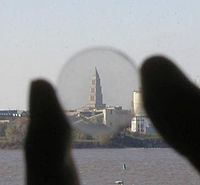
Photo from wikipedia
The films of vinylidene fluoride and trifluoroethylene (P(VDF-TrFE)) are widely used in piezoelectric tactile sensors, vibration energy harvesters, optical frequency conversion materials and organic photo-voltaic devices because of high electroactive,… Click to show full abstract
The films of vinylidene fluoride and trifluoroethylene (P(VDF-TrFE)) are widely used in piezoelectric tactile sensors, vibration energy harvesters, optical frequency conversion materials and organic photo-voltaic devices because of high electroactive, good optical and nonlinear optical properties, respectively. In this work, the multilayer structured ultrathin films were fabricated by the Langmuir–Blodgett technique, and the thickness per layer can be controlled accurately. It was found that as the collapse pressure of P(VDF-TrFE) (25:75) and the optimal dipping value are 60~70 mN/m and 15 mN/m, respectively, a high-density film can be obtained due to the compression of molecules. The surface topography and optical properties of the LB films were characterized by X-ray diffraction, white light interferometer and variable-angle spectrum ellipsometer. It was observed that the films are transparent in the visible region and IR-band, but show a high absorption in the UV band. Besides, the transmittance of the films ranges from 50% to 85% in the visible region, and it linearly decreases with the number of monolayers. The average thickness of per deposition layer is 2.447 nm, 2.688 nm and 2.072 nm, respectively, under three measurement methods. The calculated refractive index ranged from 1.443 to 1.598 (600~650 nm) by the Cauchy-model.
Journal Title: Nanomaterials
Year Published: 2022
Link to full text (if available)
Share on Social Media: Sign Up to like & get
recommendations!